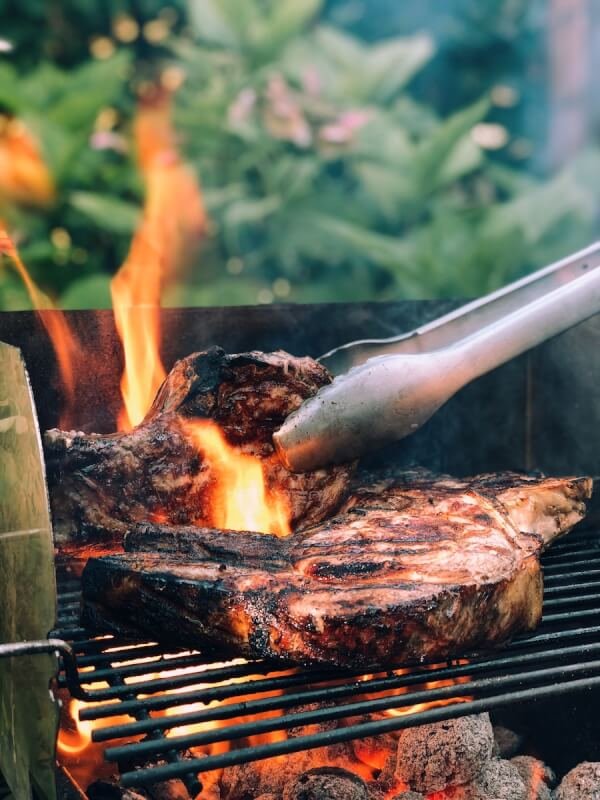Grilling meat is a beloved activity for many, especially during the warm summer months when the tantalizing aroma of sizzling steaks and juicy burgers fills the air. Whether you’re a seasoned grill master or just starting out, it’s always helpful to have a few extra tips up your sleeve to elevate your grilling game. From perfecting your marinade to achieving the ideal doneness, this article will provide you with practical and easy-to-follow tips that will ensure your grilled meats are always a hit. Get ready to impress your family and friends with mouthwatering flavors that will have them coming back for seconds.
Choosing the Right Meat
Selecting the Type of Meat
When it comes to grilling, selecting the right type of meat is crucial. You want to choose cuts that are suitable for grilling and will result in tender and juicy meat. Popular options for grilling include steaks, burgers, chicken breasts, pork chops, and seafood like shrimp and salmon. Each type of meat requires a different cooking time and technique, so make sure to consider that when making your selection.
Inspecting the Quality of Meat
Once you have chosen the type of meat you want to grill, it is important to inspect its quality. Look for fresh meat with a bright color, as this indicates freshness. Avoid meat that has any discoloration or an unpleasant odor. Additionally, check for any signs of excessive fat or sinew, as these can affect the taste and texture of the meat. Choosing high-quality meat will ensure a delicious end result.
Considering the Thickness of the Meat
The thickness of the meat you choose to grill also plays a significant role in the cooking process. Thicker cuts of meat will require longer cooking times, while thinner cuts will cook more quickly. It is important to consider the thickness of the meat to avoid undercooking or overcooking. Adjust your cooking time accordingly based on the thickness of the cut, or use a meat thermometer to ensure the meat reaches the desired internal temperature.
Preparing the Meat
Trimming Excess Fat
Before grilling, it is a good idea to trim any excess fat from the meat. While fat can add flavor and juiciness, too much fat can cause flare-ups and lead to a greasy end result. Trim the visible fat, leaving just a thin layer to enhance the taste of the meat. This will not only improve the overall texture and flavor but also make the grilling process safer.
Marinating the Meat
Marinating the meat is a fantastic way to infuse it with flavor and tenderize it. A marinade typically consists of a mixture of oil, acid (such as lemon juice or vinegar), and various herbs and spices. By soaking the meat in this flavorful liquid for a few hours or overnight, you allow the flavors to penetrate the meat, resulting in a mouthwatering and tender final product. Experiment with different marinades to discover your favorite flavors.
Brining the Meat
Brining is another method to enhance the flavor and juiciness of meat, especially poultry. It involves soaking the meat in a solution of salt and water, sometimes with the addition of sugar or other spices. The salt helps the meat retain moisture, resulting in a juicy and flavorful end result. Brining is particularly beneficial for lean cuts of meat, such as chicken breasts, which tend to dry out easily during grilling.

Preparing the Grill
Cleaning the Grill Grates
The first step in preparing the grill is to ensure that the grill grates are clean. Start by removing any debris or leftover food from the grates using a brush or scraper. This will prevent any unwanted flavors from transferring onto the meat during the grilling process. It is also advisable to clean the grates after each use to maintain their longevity and keep them in good condition.
Preheating the Grill
Preheating the grill is essential to ensure even cooking and to create those iconic grill marks. Preheat the grill to the appropriate temperature based on the type of meat you are grilling. This step allows the grates to reach the desired heat and prevents the meat from sticking to the surface, making it easier to flip and preventing any loss of moisture.
Oil the Grill Grates
To prevent the meat from sticking to the grill grates, it is important to oil them properly. Before placing the meat on the grill, lightly oil the grates using a heat-resistant cooking spray or a brush dipped in oil. This will create a non-stick surface and ensure easy removal of the meat once it is cooked. Additionally, oiling the grates helps to impart a beautiful sear and adds flavor to the meat.
Seasoning the Meat
Salt and Pepper
Salt and pepper are the fundamental seasonings when it comes to grilling meat. Before placing the meat on the grill, generously season both sides with salt and freshly ground black pepper to enhance the natural flavors. The salt helps to tenderize the meat, while the pepper adds a subtle kick. This simple seasoning combination can go a long way in achieving a deliciously flavorful grilled meat.
Dry Rubs
Dry rubs are a fantastic way to add complex flavors to your grilled meat. They consist of a blend of spices, herbs, and sometimes sugar, which is generously rubbed onto the surface of the meat. Allow the rubbed meat to sit for some time, allowing the flavors to infuse into the meat before grilling. Dry rubs can be customized according to personal preferences, and various combinations can be explored to create unique and delicious flavors.
Wet Marinades
In addition to dry rubs, wet marinades can take your grilled meat to the next level. Wet marinades typically include a mixture of oil, acid, and various herbs and spices. The meat is soaked in this flavorful liquid for a period of time, allowing the flavors to penetrate deep into the meat. Wet marinades not only enhance the taste but also add moisture, resulting in succulent and mouthwatering grilled meat.

Grilling Techniques
Direct Heat Grilling
Direct heat grilling is a popular method used for cooking smaller and thinner cuts of meat. In this technique, the meat is placed directly over the heat source, typically high heat, on the grill. Direct heat grilling is perfect for achieving a quick sear, creating grill marks, and cooking the meat to perfection in a relatively short amount of time. This technique is ideal for steaks, burgers, and boneless chicken breasts.
Indirect Heat Grilling
Indirect heat grilling is a method commonly used for larger cuts of meat or items that require longer cooking times. In this technique, the heat source is placed on one side of the grill, while the meat is placed on the other side, away from the flames. This allows for slower, more even cooking, as the heat circulates around the meat rather than directly cooking it. Indirect heat grilling is perfect for roasts, whole chickens, and ribs.
Reverse Searing
Reverse searing is a technique that involves slowly cooking the meat at a low temperature first and then finishing it off with a quick sear at high heat. This method is often used for thicker cuts of meat, such as steaks, to achieve a perfectly cooked interior with a flavorful, caramelized exterior. By reversing the traditional grilling process, the meat retains more moisture and tends to have a more evenly cooked center.
Temperature Control
Using a Meat Thermometer
Using a meat thermometer is essential for achieving perfectly cooked meat. Different types of meat require specific internal temperatures to be considered safe and cooked to the desired doneness. Insert the meat thermometer into the thickest part of the meat, away from any bones, to get an accurate reading. This will help you avoid undercooking or overcooking the meat and ensure that it is cooked to your preference.
Monitoring Grill Temperature
In addition to monitoring the internal temperature of the meat, it is crucial to keep an eye on the temperature of the grill itself. Different types of meat and cooking techniques require specific grill temperatures to achieve optimal results. Use a grill thermometer or the built-in temperature gauge on your grill to ensure that the heat is consistent and within the desired range throughout the grilling process.
Creating Heat Zones
Creating heat zones on your grill is a useful technique for controlling the cooking process. By having different areas of the grill with varying heat levels, you can sear the meat over high heat and then move it to a lower heat zone to finish cooking without burning the exterior. This technique is especially effective for larger cuts of meat or when using both direct and indirect heat grilling methods simultaneously.
Grilling Times
Understanding Cooking Times
Understanding the cooking times for different types of meat is crucial for achieving perfectly cooked results. The cooking time will depend on various factors such as the thickness of the meat, the type of meat, and the desired level of doneness. Refer to cooking guides or recipes for specific cooking times, but always remember that cooking times are just guidelines, and it is important to use a meat thermometer to confirm that the meat has reached the appropriate internal temperature.
Factors Affecting Cooking Times
Several factors can affect the cooking times of grilled meat. The thickness of the cut will significantly impact how long it takes for the meat to cook through. Thicker cuts will require more time, while thinner cuts will cook more quickly. Additionally, the initial temperature of the meat, the grill temperature, and the cooking technique used will affect the overall cooking time. Be aware of these factors and make adjustments accordingly for perfectly cooked meat.
Resting the Meat
After removing the meat from the grill, it is essential to let it rest before slicing or serving. Resting allows the juices to redistribute within the meat, resulting in a more succulent and flavorful bite. Depending on the size of the meat, a good rule of thumb is to let it rest for about 5 to 10 minutes under a tent of foil. Use this time to prepare any sides or garnishes and eagerly anticipate the delicious flavors that await.
Grill Maintenance
Regular Grill Cleaning
Regularly cleaning your grill is essential for both maintaining its performance and ensuring the safety of the food you cook. After each use, remove any leftover food debris from the grates using a brush or scraper. Deep clean the grill periodically by removing the grates and using warm soapy water to clean them thoroughly. Clean the internal components and the exterior of the grill as well. Keeping your grill clean will prolong its lifespan and prevent any unwanted flavors from transferring onto your food.
Proper Grill Storage
Proper storage is another important aspect of grill maintenance. If you live in an area prone to extreme weather conditions or do not plan on using your grill for an extended period, it is advisable to store it in a protected area such as a shed or garage. Covering it with a grill cover will also help protect against dust, dirt, and other elements. Properly storing your grill will ensure its longevity and keep it in optimal condition for future grilling adventures.
Replacing Grill Parts
Over time, certain parts of your grill may wear out or become damaged. It is important to inspect your grill regularly and replace any worn or broken parts as needed. This can include components such as grill grates, burners, ignitors, and propane tanks. By maintaining and replacing necessary parts, you can keep your grill functioning properly and avoid any potential safety hazards. Consult the manufacturer’s instructions or contact a professional if you have any concerns about replacing grill parts.
Safety Tips
Handling Raw Meat
When grilling, it is important to prioritize proper food safety practices, especially when handling raw meat. Start by washing your hands thoroughly before and after handling raw meat to prevent cross-contamination. Use separate cutting boards and utensils for raw and cooked foods to avoid spreading bacteria. It is also essential to cook meat to the appropriate internal temperature to ensure it is safe to eat. Follow recommended guidelines and best practices for safe handling of raw meat to protect yourself and your guests.
Grilling in a Well-Ventilated Area
Grilling should always be done in a well-ventilated area to avoid the buildup of smoke and gases. Grilling in an open space, such as a backyard or patio, allows any smoke or fumes to disperse easily, reducing the risk of inhaling harmful substances. Adequate ventilation ensures a safer and more enjoyable grilling experience for everyone involved.
Avoiding Cross-Contamination
Cross-contamination occurs when harmful bacteria from raw meat come into contact with cooked or ready-to-eat foods, potentially leading to foodborne illnesses. To avoid cross-contamination when grilling, it is crucial to keep raw meat separate from other ingredients. Use separate plates, utensils, and cutting boards for raw and cooked foods. Ensure that the surfaces and utensils used for raw meat are thoroughly washed before reusing them for other purposes. These simple steps will help mitigate the risk of foodborne illnesses and keep your grilling experience safe.
Serving Suggestions
Letting the Meat Rest
After the meat has rested, it is time to slice and serve it. However, do not rush into slicing the meat immediately after it comes off the grill. Letting the meat rest allows the juices to distribute evenly, resulting in a more tender and flavorful final product. Use this time to prepare any accompanying sides or gather your guests around the table. Patience will be rewarded with a juicy and delicious meal.
Slicing and Presenting
When it comes to slicing grilled meat, it is important to cut it against the grain. Cutting against the grain helps to break up the muscle fibers and results in a more tender and less chewy bite. Slice the meat into thin, uniform pieces, and arrange them on a serving platter or individual plates. Garnish with fresh herbs or a squeeze of citrus for an extra pop of flavor and an appetizing presentation.
Pairing with Sides
Grilled meat pairs exceptionally well with a variety of sides, adding flavor, texture, and balance to your meal. Consider serving grilled vegetables, such as corn on the cob, asparagus, or zucchini, to complement the meaty flavors. Salads, whether it be potato salad, coleslaw, or a green salad, can add freshness and acidity to balance the richness of the meat. Don’t forget to include condiments like barbecue sauce, chimichurri, or a homemade marinade to further enhance the flavors. The possibilities are endless when it comes to pairing sides with grilled meat, so get creative and enjoy the delicious combination.


